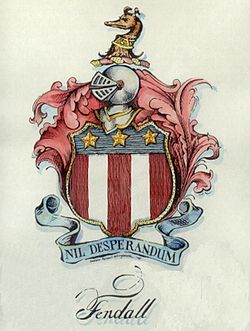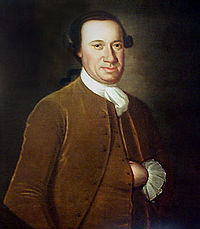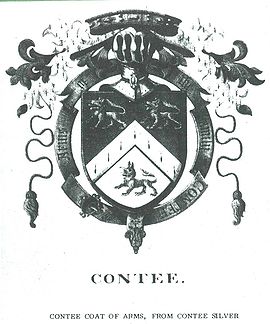
Thomas Contee
Encyclopedia
Col. Thomas Contee of "Brookefield", near Nottingham, Prince George's County, Maryland
. American Patriot, militia man, politician, planter.
. Thomas and Sarah resided at "Brookefield", which is now called "The Valley", near Nottingham
, Prince George's Co., Maryland.
 Sarah (Fendall) Contee (1732-1793), was the daughter of Benjamin Fendall I, Esq. (1708-1764) and first wife, Eleanor Lee (1710-1759). Sarah was born February 7, 1732 at "Potomoe", Charles County., Maryland. Sarah was described as a very beautiful woman with a wealth of golden hair.
Sarah (Fendall) Contee (1732-1793), was the daughter of Benjamin Fendall I, Esq. (1708-1764) and first wife, Eleanor Lee (1710-1759). Sarah was born February 7, 1732 at "Potomoe", Charles County., Maryland. Sarah was described as a very beautiful woman with a wealth of golden hair.
Thomas inherited through his mother, the estate "Brookefield", the original home of his ancestor, Maj. Thomas Brooke, Sr.
, Esq. (1632-1676). Thomas was a merchant by 1764, and was an attorney in fact for William Molleson, of London, England in 1766. He was engaged in a tobacco trade business with Capt. Fielder Bowie (ca. 1745-1794), which imported large quantities of goods until the firm disbanded in 1775. Thomas had management of a store at Pig Point, in Prince George’s County from 1772-1775, and was an agent for his sons Alexander and Benjamin, in Nottingham, and Upper Marlboro
.
to confer with the Continental Congress
as to the proper organization of the army and the general plans for defense. Thomas also served as Chairman of the Patuxent Associators.
A picture of Col. Contee shows a mild, handsome face and powdered hair. According to the 1790 census, Thomas owned 25 slaves.
 Thomas' older sister Jane Hanson, married John Hanson
Thomas' older sister Jane Hanson, married John Hanson
(1721-1783), of “Mulberry Grove
”, who some say was the first President of the United States. On November 5, 1781, he was elected by a large majority, President of the Congress and in 1782, as head of the new nation, issued letters of marque to prey upon the British Commerce. These commissions were signed "John Hanson, President"; from which fact he is spoken of as the first President of the United States.

Jane was the daughter of Col. Thomas Brooke, Jr.
, Hon. (1660-1730) of "Brookefield", President of Maryland and his second wife, Barbara Dent (1676-1754).
Col. Thomas Brooke, Jr., was the son of Maj. Thomas Brooke, Sr.
, Esq. (1632-1676), of “Brookefield”, and Eleanor (Hatton) Darnall (1642-1745), who married secondly Col. Henry Darnall, Sr. (1645-1711).
Alexander was the son of Dr. Peter Contee (d. 1714), of Barnstaple
, Devon
shire, England, and his first wife Catherine. Peter immigrated in about 1703 and resided in Charles County, before taking up permanent residence in Prince George’s County. Peter was a surgeon, and married secondly, Francis (?) Hopkins. Francis was the widow of Capt. William Hopkins
(d. 1702).
Peter was the son of Adolphe de Conti and his wife Grace. Adolphe was a Huguenot
who immigrated to England from France during the reign of Louis XIII, King of France (1601-1643). Adolphe was lord mayor of London, England, in 1643, and High Sheriff of Middlesex, England. The motto under his Arms in Guild Hall, London is, “pour dieu et mon roi” ("for God and my king").
Alexander, was born in April of 1693, in Barnstaple, Devonshire, England. He immigrated around 1703, and resided in Charles County about 1720. He joined his uncle, Col. John Contee (d. 1708), who though married twice, had no children, and whose will provided liberally for Alexander. Alexander was a prosperous merchant at Nottingham Prince George's Co., Clerk of the Court; and from 1720 to 1724, member of the Lower House of the General Assembly. He was a vestryman of St. Paul's Parish. He married about 1720, Jane Brooke. Jane inherited a portion of “Brookefield”, her father’s estate. “Brookefield” is now known as “The Valley”, and was located near Nottingham in Prince George’s County. At the time of his death on December 24, 1740, Alexander had amassed at least 2598 acres (11 km²) of land, and his estate was valued at 1,613.2.11 pounds sterling, plus 3,827.19.8 pounds current money. This included 32 slaves, 2 servants, books, and clerk’s writing equipment. Alexander’s will contained a heraldic shield only, with a chevron on which are charges and beasts in dexter, middle and sinister chief and middle base. The arms of the Conte of Montulle, Normandy, contain a chevron and three mullets described as “Azure chevron or between three mullets or”.
The Contees came to Maryland from England, but they were of French descent Huguenots, who emigrated to Barnstable, in Devonshire, to escape the religious persecutions which culminated in the revocation of the Edict of Nantes
. The name originally de Conti, appears among the French nobility from a very early date. As far back as 1375, Isabella, dame de Conti, married Colard de Mailly. Their great granddaughter married in 1551, Louis I, Prince de Conde, a cadet of the Bourbons who ascended the French throne in the person of Henry IV, King of France and Navare (1553-1610). The second son of this latter marriage, Francois de Bourbon, was Prince de Conti, but had no issue and the title was revived from Armand de Bourbon, a cadet of the great Conde but expired for lack of male issue. The Vicomte de Conti arms are identical with those of the Rochelle family and also with those of the Marquis de Graviers, Comte de Noirant (of Normandy) and Baron de Conti (of Orange).
Prince George's County, Maryland
Prince George's County is a county located in the U.S. state of Maryland, immediately north, east, and south of Washington, DC. As of 2010, it has a population of 863,420 and is the wealthiest African-American majority county in the nation....
. American Patriot, militia man, politician, planter.
Married
Thomas married Sarah Fendall (1732-1793) in 1751 in Charles County, MarylandCharles County, Maryland
Charles County is a county in the south central portion of the U.S. state of Maryland.As of 2010, the population was 146,551. Its county seat is La Plata. This county was named for Charles Calvert , third Baron Baltimore....
. Thomas and Sarah resided at "Brookefield", which is now called "The Valley", near Nottingham
Nottingham, Maryland
Nottingham is an unincorporated community in Baltimore County, Maryland, United States. Its elevation is 62 feet . Although Nottingham is unincorporated, it has a post office, with the ZIP code of 21236....
, Prince George's Co., Maryland.

Thomas inherited through his mother, the estate "Brookefield", the original home of his ancestor, Maj. Thomas Brooke, Sr.
Thomas Brooke, Sr.
Major Thomas Brooke, Sr., Esq. was a colonial lawyer, planter and politician of Calvert County, Maryland, where he served in the appointed positions of Burgess, High Sheriff and Chief Justice.-Early life and education:...
, Esq. (1632-1676). Thomas was a merchant by 1764, and was an attorney in fact for William Molleson, of London, England in 1766. He was engaged in a tobacco trade business with Capt. Fielder Bowie (ca. 1745-1794), which imported large quantities of goods until the firm disbanded in 1775. Thomas had management of a store at Pig Point, in Prince George’s County from 1772-1775, and was an agent for his sons Alexander and Benjamin, in Nottingham, and Upper Marlboro
Upper Marlboro, Maryland
Upper Marlboro is a town in and the county seat of Prince George's County, Maryland, United States. The live-in population of the town core proper was only 648 at the 2000 census, although Greater Upper Marlboro is many times larger....
.
Children
- Alexander Contee (1752-1810), who never married.
- Capt. Benjamin ConteeBenjamin ConteeBenjamin Contee was an American Episcopal priest and statesman from Maryland. He was an officer in the American Revolutionary War, a delegate to the Confederation Congress, and member of the first United States House of Representatives.-Early life:Contee was the son of Col. Thomas Contee and...
, Rev., Hon. (1755-1815), who married Sarah Russell Lee (1766-1810), daughter of Philip Thomas Lee (1736-1778) and Ann Russell (d. 1777). - Eleanor Lee Contee (1758-1786), who married Dr. Michael Wallace, Jr., Esq. (1749-1794).
- Jane Contee (1761-1825), who married William WorthingtonWilliam WorthingtonWilliam Worthington may refer to:* William Worthington American silent film actor and director* William Worthington , Anglican priest and theological writer...
(1747-1820). - Sarah Contee (1767-1844), who married David SlaterDavid SlaterDavid Slater is an American singer.-Career:He was the Male Vocalist champion on TV's Star Search in 1987. Slater then signed a recording contract with Capitol Records and launched a country music career. He released two critically acclaimed albums on Capitol in the late 1980s entitled and . Both...
(ca. 1763).
Revolutionary War
During the Revolutionary period he took a conspicuous position. He was chairman of various meetings of the citizens in Marlboro, was member of the House of Burgesses (Maryland), a delegate to the first convention held at Annapolis in 1770, and was one of the signers of the Declaration of Association of Freeman of Maryland in 1775. In September of the same year he was elected to the Committee of Observation. Too old for active duty, Thomas in 1776 was commissioned a Major of Militia by the Council of Safety and instructed to inspect the newly raised troops and to aid in the equipment of the volunteer forces. In November of 1776, he was elected a member of the Council of Safety which continued to act until March 20, 1777, when the new state government was organized. He was sent to PhiladelphiaPhiladelphia, Pennsylvania
Philadelphia is the largest city in the Commonwealth of Pennsylvania and the county seat of Philadelphia County, with which it is coterminous. The city is located in the Northeastern United States along the Delaware and Schuylkill rivers. It is the fifth-most-populous city in the United States,...
to confer with the Continental Congress
Continental Congress
The Continental Congress was a convention of delegates called together from the Thirteen Colonies that became the governing body of the United States during the American Revolution....
as to the proper organization of the army and the general plans for defense. Thomas also served as Chairman of the Patuxent Associators.
Public service
Thomas was elected to the state legislature and for many years was chairman of the Republican Party in Prince George's County. Thomas was a vestryman for St. Pauls’s Parish, Prince George’s County. In 1811, at the time of his death, Thomas had amassed 1082 acres (4 km²) in Prince George’s, Baltimore, and Frederick counties, 4 lots in Prince George’s and Montgomery counties, plus 4833 acres (20 km²) in Kentucky. His estate was valued at $9,167.75, including 19 slaves, books, and silver.A picture of Col. Contee shows a mild, handsome face and powdered hair. According to the 1790 census, Thomas owned 25 slaves.

John Hanson
John Hanson was a merchant and public official from Maryland during the era of the American Revolution. After serving in a variety of roles for the Patriot cause in Maryland, in 1779 Hanson was elected as a delegate to the Continental Congress...
(1721-1783), of “Mulberry Grove
Mulberry Grove
Mulberry Grove may refer to:* Mulberry Grove Site, Port Wentworth, GA, listed on the NRHP in Georgia*Mulberry Grove, Illinois* Mulberry Grove * Mulberry Grove , listed on the NRHP in Louisiana...
”, who some say was the first President of the United States. On November 5, 1781, he was elected by a large majority, President of the Congress and in 1782, as head of the new nation, issued letters of marque to prey upon the British Commerce. These commissions were signed "John Hanson, President"; from which fact he is spoken of as the first President of the United States.

Ancestry of Thomas Contee
Thomas was the son of Alexander Contee (1693-1740) and Jane Brooke (1702-1779).Jane was the daughter of Col. Thomas Brooke, Jr.
Thomas Brooke, Jr.
Colonel Thomas Brooke, Jr., of Brookefield was President of the Council in Maryland and acting 13th Proprietary Governor of Maryland. He was the son of Major Thomas Brooke, Esq. and his second wife Eleanor Hatton .In 1720 he was elected President of the Council, and acting Governor of Maryland...
, Hon. (1660-1730) of "Brookefield", President of Maryland and his second wife, Barbara Dent (1676-1754).
Col. Thomas Brooke, Jr., was the son of Maj. Thomas Brooke, Sr.
Thomas Brooke, Sr.
Major Thomas Brooke, Sr., Esq. was a colonial lawyer, planter and politician of Calvert County, Maryland, where he served in the appointed positions of Burgess, High Sheriff and Chief Justice.-Early life and education:...
, Esq. (1632-1676), of “Brookefield”, and Eleanor (Hatton) Darnall (1642-1745), who married secondly Col. Henry Darnall, Sr. (1645-1711).
Alexander was the son of Dr. Peter Contee (d. 1714), of Barnstaple
Barnstaple
Barnstaple is a town and civil parish in the local government district of North Devon in the county of Devon, England, UK. It lies west southwest of Bristol, north of Plymouth and northwest of the county town of Exeter. The old spelling Barnstable is now obsolete.It is the main town of the...
, Devon
Devon
Devon is a large county in southwestern England. The county is sometimes referred to as Devonshire, although the term is rarely used inside the county itself as the county has never been officially "shired", it often indicates a traditional or historical context.The county shares borders with...
shire, England, and his first wife Catherine. Peter immigrated in about 1703 and resided in Charles County, before taking up permanent residence in Prince George’s County. Peter was a surgeon, and married secondly, Francis (?) Hopkins. Francis was the widow of Capt. William Hopkins
William Hopkins
William Hopkins FRS was an English mathematician and geologist. He is famous as a private tutor of aspiring undergraduate Cambridge mathematicians, earning him the sobriquet the senior-wrangler maker....
(d. 1702).
Peter was the son of Adolphe de Conti and his wife Grace. Adolphe was a Huguenot
Huguenot
The Huguenots were members of the Protestant Reformed Church of France during the 16th and 17th centuries. Since the 17th century, people who formerly would have been called Huguenots have instead simply been called French Protestants, a title suggested by their German co-religionists, the...
who immigrated to England from France during the reign of Louis XIII, King of France (1601-1643). Adolphe was lord mayor of London, England, in 1643, and High Sheriff of Middlesex, England. The motto under his Arms in Guild Hall, London is, “pour dieu et mon roi” ("for God and my king").
Alexander, was born in April of 1693, in Barnstaple, Devonshire, England. He immigrated around 1703, and resided in Charles County about 1720. He joined his uncle, Col. John Contee (d. 1708), who though married twice, had no children, and whose will provided liberally for Alexander. Alexander was a prosperous merchant at Nottingham Prince George's Co., Clerk of the Court; and from 1720 to 1724, member of the Lower House of the General Assembly. He was a vestryman of St. Paul's Parish. He married about 1720, Jane Brooke. Jane inherited a portion of “Brookefield”, her father’s estate. “Brookefield” is now known as “The Valley”, and was located near Nottingham in Prince George’s County. At the time of his death on December 24, 1740, Alexander had amassed at least 2598 acres (11 km²) of land, and his estate was valued at 1,613.2.11 pounds sterling, plus 3,827.19.8 pounds current money. This included 32 slaves, 2 servants, books, and clerk’s writing equipment. Alexander’s will contained a heraldic shield only, with a chevron on which are charges and beasts in dexter, middle and sinister chief and middle base. The arms of the Conte of Montulle, Normandy, contain a chevron and three mullets described as “Azure chevron or between three mullets or”.
The Contees came to Maryland from England, but they were of French descent Huguenots, who emigrated to Barnstable, in Devonshire, to escape the religious persecutions which culminated in the revocation of the Edict of Nantes
Edict of Nantes
The Edict of Nantes, issued on 13 April 1598, by Henry IV of France, granted the Calvinist Protestants of France substantial rights in a nation still considered essentially Catholic. In the Edict, Henry aimed primarily to promote civil unity...
. The name originally de Conti, appears among the French nobility from a very early date. As far back as 1375, Isabella, dame de Conti, married Colard de Mailly. Their great granddaughter married in 1551, Louis I, Prince de Conde, a cadet of the Bourbons who ascended the French throne in the person of Henry IV, King of France and Navare (1553-1610). The second son of this latter marriage, Francois de Bourbon, was Prince de Conti, but had no issue and the title was revived from Armand de Bourbon, a cadet of the great Conde but expired for lack of male issue. The Vicomte de Conti arms are identical with those of the Rochelle family and also with those of the Marquis de Graviers, Comte de Noirant (of Normandy) and Baron de Conti (of Orange).

